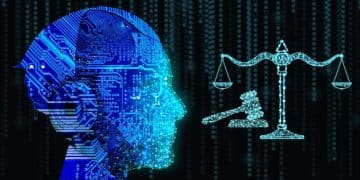Bias detection in AI algorithms: why it matters

Bias detection in AI algorithms is crucial for identifying and mitigating unfair practices in machine learning, ensuring that artificial intelligence systems operate equitably and do not perpetuate discrimination.
Bias detection in AI algorithms plays a vital role in ensuring that artificial intelligence systems operate fairly and effectively. Are we truly aware of how bias can seep into our algorithms? In this article, we will dive into the significance of detecting bias in AI and its broader implications.
Understanding AI bias and its origins
To grasp the impact of AI, we first need to understand bias and its origins. Bias in algorithms often begins with the data we use. When training AI systems, if the data is skewed or unrepresentative, the algorithms will reflect those biases.
This shows why proper data selection is crucial. Without careful curation, AI may produce results that are discriminatory or inaccurate. So, what can contribute to bias in AI?
Key Contributors to AI Bias
Several factors can lead to bias in AI systems:
- Lack of diverse data sets used for training.
- Human biases reflected in the training data.
- Insufficient testing for fairness.
- Over-reliance on historical data that may contain biases.
Understanding these factors helps us realize that bias detection in AI is not just about identifying problems; it’s about proactive measures to improve fairness.
Moreover, the implications of biased AI can be far-reaching. If an AI model used in hiring overlooks qualified candidates due to biased training data, companies may miss out on diverse talents. This underlines the urgent need for awareness and solutions.
Rectifying bias in AI involves collaboration across multiple fields, including data science, ethics, and law. Experts aim to develop frameworks that not only identify bias but also establish best practices for mitigating its effects.
As we explore bias detection, it is essential to engage all stakeholders. By promoting an inclusive approach to data gathering and algorithm design, we enhance the overall reliability and fairness of AI technologies.
The impact of bias on AI decision-making
The impact of bias on AI decision-making is profound and far-reaching. When algorithms are trained on biased data, their predictions and recommendations can mirror those biases, leading to unfair outcomes.
For example, in hiring processes, an AI might favor candidates from certain demographics while disregarding equally qualified individuals from underrepresented backgrounds. This can perpetuate inequality and discrimination in the workplace.
Consequences of Biased AI
Several consequences arise from biased decision-making:
- Discrimination against marginalized groups.
- Loss of trust in AI systems.
- Legal and regulatory repercussions for organizations.
- Negative impacts on brand reputation.
Such outcomes emphasize the need for robust bias detection strategies. By identifying biases early in the development process, organizations can take steps to mitigate their impact.
Moreover, biased AI systems can damage not just individuals, but entire industries. For instance, in healthcare, biased algorithms could lead to a lack of proper treatment recommendations for certain populations, affecting health outcomes across various groups.
Awareness and proactive measures are crucial in addressing bias. Algorithms should be continuously audited to ensure they reflect fairness and equity. Collaboration among data scientists, ethicists, and industry leaders is essential to create AI systems that prioritize unbiased decision-making.
Effective techniques for bias detection

Effective techniques for bias detection are essential in ensuring fairness in AI systems. Identifying bias early helps prevent unfair outcomes that could affect individuals and society.
One common method in bias detection is data auditing. This technique involves reviewing datasets for representation issues. By ensuring diverse samples, we can mitigate potential biases in model training.
Key Techniques for Bias Detection
Here are several effective techniques:
- Statistical Analysis: Use statistical methods to analyze the performance of AI models across different demographic groups.
- Algorithmic Fairness Checks: Implement fairness metrics to evaluate how algorithms perform for various populations.
- Human-in-the-loop Systems: Involve human oversight in the decision-making process to review and adjust AI outcomes.
- Simulations: Run scenarios to observe how AI behaves under different conditions and detect potential biases.
Combination of these techniques allows for a comprehensive approach to bias detection. Employing diverse strategies ensures that potential problems are identified and addressed effectively.
Another effective method is feedback loops. Creating channels for users to report biased outcomes fosters a culture of accountability. Organizations can then update their models based on real-world experiences, leading to better AI performance over time.
Ultimately, integrating bias detection techniques should be ongoing throughout the AI lifecycle. It is not just a one-time task but a continuous process of monitoring and improvement. This proactive approach helps maintain the integrity and fairness of AI systems.
Case studies of bias in AI systems
Case studies of bias in AI systems reveal significant challenges faced in the implementation of artificial intelligence. These real-world examples illustrate how algorithms can produce biased outcomes, raising awareness of the importance of bias detection.
For instance, an AI tool used in hiring practices showed a strong preference for candidates with certain educational backgrounds. Applicants from other universities received lower scores, regardless of their qualifications. This bias not only affected individual careers but also limited the diversity of ideas within organizations.
Notable Examples
Here are some notable case studies:
- Facial Recognition: Various studies found that facial recognition systems were less accurate for people of color and women, leading to misidentifications.
- Healthcare Algorithms: Research revealed that certain healthcare algorithms underestimated the health needs of Black patients, impacting treatment and care.
- Credit Scoring: AI used in credit scoring sometimes discriminated against minority groups, leading to unfair lending practices.
These examples highlight that biases can arise from the data, the design of the algorithms, or both. Addressing these issues requires a cooperative effort among technologists, ethicists, and affected communities.
Incorporating transparency into algorithmic decisions is vital. Organizations must evaluate models regularly and adjust them based on bias indicators. By sharing findings from case studies, companies can learn from past mistakes and create more equitable AI solutions.
Ultimately, understanding the implications of bias through these case studies fosters a culture of accountability in AI development. Continuous learning and adaptation are key to building systems that prioritize fairness and inclusion.
Future directions for unbiased AI development
Future directions for unbiased AI development focus on promoting fairness and accountability. As technology evolves, so does the need to improve our approaches to bias detection and mitigation.
One important direction is the integration of ethics into AI design. This means involving ethicists and diverse perspectives from the start of the development process. By doing so, we can create systems that are more just and inclusive.
Emerging Strategies
Several strategies are gaining traction in the field:
- Inclusive Data Practices: Gathering diverse data sets that better represent the populations affected by AI systems.
- Transparent Algorithms: Making the workings of AI systems more understandable to users and stakeholders.
- Continuous Monitoring: Regularly evaluating AI systems for biases as they evolve and adapt.
- Collaboration Across Fields: Engaging interdisciplinary teams to address bias from various angles.
These strategies emphasize the importance of a proactive and collaborative approach to AI development. By fostering partnerships among developers, regulators, and community groups, we can work towards shared goals of fairness.
Educating stakeholders about the implications of AI bias is also crucial. Workshops and training can help teams understand the impacts of their work. This knowledge will empower them to make informed decisions that promote equity.
As we look ahead, adopting best practices in bias mitigation must be a priority. This includes creating standards for measuring and reporting biases in AI systems. Such measures encourage accountability and drive improvements in technology.
FAQ – Frequently Asked Questions about Bias Detection in AI
What is bias detection in AI?
Bias detection in AI involves identifying and mitigating unfair patterns in algorithms that can lead to discriminatory outcomes.
Why is bias detection important?
It is crucial because biased AI systems can perpetuate discrimination and inequality, affecting individuals and society negatively.
What are some techniques for detecting bias in AI?
Techniques include data auditing, statistical analysis, algorithmic fairness checks, and user feedback loops.
How can organizations ensure fairness in AI systems?
Organizations can ensure fairness by leveraging diverse teams, implementing transparent algorithms, and continuously monitoring AI performance.





